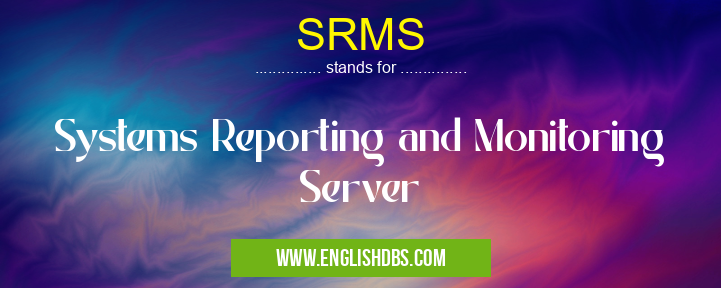What does SRMS mean in NETWORKING
SRMS stands for Systems Reporting and Monitoring Server. It is a type of server software that helps to monitor, report, and manage different computer systems or networks. In large organizations, it is used to provide continuous monitoring of the system so as to ensure optimal performance. The SRMS can also be used to detect any suspicious activity on the system and help take corrective measures in such cases.

SRMS meaning in Networking in Computing
SRMS mostly used in an acronym Networking in Category Computing that means Systems Reporting and Monitoring Server
Shorthand: SRMS,
Full Form: Systems Reporting and Monitoring Server
For more information of "Systems Reporting and Monitoring Server", see the section below.
» Computing » Networking
Benefits Of SRMS
The most important benefit of using an SRMS is its ability to provide complete visibility into system performance and activity. By monitoring all activities happening on the network, administrators can identify potential problems and take prompt action before they cause too much damage or disruption to other parts of the network. The SRMS also allows administrators to define policies that can control access and privileges for various users on the network and ensure compliance with regulations. Moreover, with an SRMS in place, organizations can experience improved performance in their computer systems as well as better overall security for data stored in these systems.
Essential Questions and Answers on Systems Reporting and Monitoring Server in "COMPUTING»NETWORKING"
What is Systems Reporting and Monitoring Server?
SRMS (Systems Reporting and Monitoring Server) is an application-based system that collects, stores, and analyzes data from various sources for performance management. It helps to monitor system performance, detect problems, generate reports based on the collected data, and provide analytics for better decision making.
What type of data does SRMS collect?
SRMS collects data from a variety of sources such as databases, applications, servers, networks, users' interaction, etc. The available metrics vary based on the type of source and the installed modules in the system.
Does SRMS support different operating systems?
Yes. SRMS supports Windows and Unix/Linux operating systems.
Is it difficult to set up SRMS?
No. Setting up SRMS is relatively easy because it has a streamlined installation process that can be managed without any complexity.
What does the reporting function do in SRMS?
The reporting module in SRMS generates graphical reports based on the data collected from different sources with configurable filters that help to customize the report contents according to user requirements.
Does SRMS have an alerting mechanism?
Yes. The alerting mechanism in Srms allows administrators to receive notifications when certain conditions are met such as threshold values are exceeded or when critical issues occur across different components of the platform.
Final Words:
In conclusion, an SRMS is a server software that provides efficient management capabilities by offering complete visibility into system performance and activities on a network or system. It also has many benefits such as improved performance, better compliance with regulations, better security for data stored on systems, etc., which make it an important asset for any organization dealing with large amounts of data on its computers or networks.
SRMS also stands for: |
|
| All stands for SRMS |
